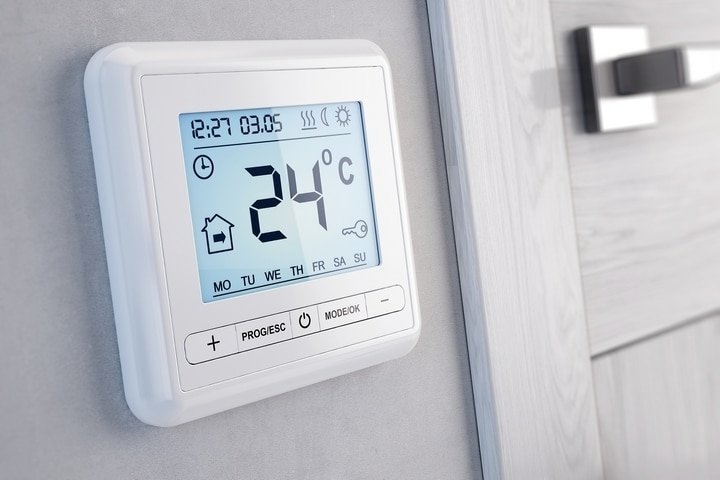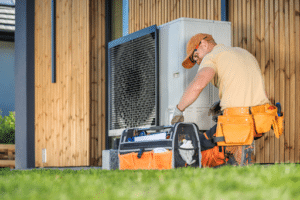A thermostat regulates your heating or cooling systems. When it is functioning properly, the thermostat plays a central role in circulating the warm or cold air throughout your building. Click a few buttons, and you can adjust the settings to control the exact temperature of your house.
However, there are times when your thermostat device does not function properly. No matter which thermostat model you use, glitches do happen from time to time. Occasionally, you may need to call an HVAC professional for help. In most cases, you may be able to troubleshoot why your thermostat is not working.
The most common issues with a thermostat can be easily corrected if you know what to check for. Below are seven reasons why your thermostat is not working:
1. The thermostat is not working because of its age.

Age is one of the most common problems associated with a faulty thermostat. Over time, the thermostat may become less effective through natural wear and tear. Remember, thermostats are not meant to last forever. Besides, an outdated model may cost you money in wasted energy and time tinkering with it.
If the thermostat is not working properly, it should be time to replace your older model with a newer one. For those still using a mechanical thermostat, which is the most basic type of thermostats, replace it with a programmable thermostat that is easy to use and simple to connect to your existing system.
2. The thermostat is not working because it has wonky wiring or parts.

Loose connection, disconnection, and faulty wiring can cause your thermostat to malfunction. Inspect the wiring in your thermostat and fasten any noticeably loose wires. Consider replacing the worn-out cables or consult a knowledgeable HVAC professional to solve your wiring problems.
Inside the mechanical thermostats, there is an electrical resistor device that informs the thermostat when to turn off the system. If not functioning correctly, it may cause your furnace to cycle on and off more frequently than necessary. The electrical resistor devices can be adjusted, ideally using an amp to determine the proper settings. For programmable thermostats, these devices come equipped with a built-in anticipator that sets itself automatically.
3. The thermostat is not working because of programming defects.

If the thermostat system is not working, there could be a system glitch in its programming. This often occurs during an abrupt power failure, which could interfere with the regular functions of the programming chips inside the thermostats. To correct this problem, you will need to reprogram the chip. There are also programmable thermostats with stronger memory systems that stay intact even after a power failure.
4. The thermostat is not working because it ran out of batteries.

During power outages, the batteries help to retain the thermostat settings. These batteries should last at least one year, although many homeowners fail to replace them until it’s too late. If the batteries are near depletion, it will disrupt the thermostat’s ability to manage the heating and cooling processes.
Most programmable thermostats display a warning symbol when the batteries start to run low. When the display goes blank, it means the batteries are completely depleted. At this point, the thermostat can no longer control the HVAC system, leading to extreme temperature levels. To replace them, you will need AA or AAA alkaline or lithium batteries, depending on the thermostat model.
5. The thermostat is not working because of its location in the building.

A suboptimal location may be the reason why your thermostat is not working. In general, you should avoid installing the thermostat at places where there is direct sunlight or near exterior doorways, since this will compromise its function. In addition, you should mount the thermostat on a wall with a high thermal coefficient.
If you believe your thermostat isn’t suitably located, move it to a better spot. For optimal comfort, place your thermostat in a central location that allows the evenest temperature distribution.
6. The thermostat is not working due to a problem with the circuit breaker.

The circuit breaker is a switch that protects your home from electrical surges. If a circuit breaker trips repeatedly, this will cause your thermostat to stop working. The key is to reduce the electrical load on the circuit by moving appliances. Get an electrician to perform an extensive upgrade, which may include adding more circuits to your system.
Some circuit breakers trip for no other reason than simple wear and tear. Call a professional immediately if you start experiencing regular circuit outages, detect a burning odour, or notice signs of deterioration around the circuit breaker. Ignoring electrical problems can result in fire and other hazards in your home. Keep the circuit breaker off until the problem is investigated and addressed.
7. The thermostat is not working due to the dirt and debris.

Over time, dust accumulates inside your thermostat. A buildup of debris and dirt could cause an inaccurate temperature reading, which may escalate to a sudden system failure. To clean the thermostat, you need to remove the cover and gently clean its interior components, including the bimetallic switch and the coil contact areas.
First, make sure the thermostat is adjusted to its lowest settings. Then, use a soft brush to clean the bimetallic coil. Next, set the thermostat to its highest level and clean the coil again. Once this is done, readjust the thermostat to your desired settings.



